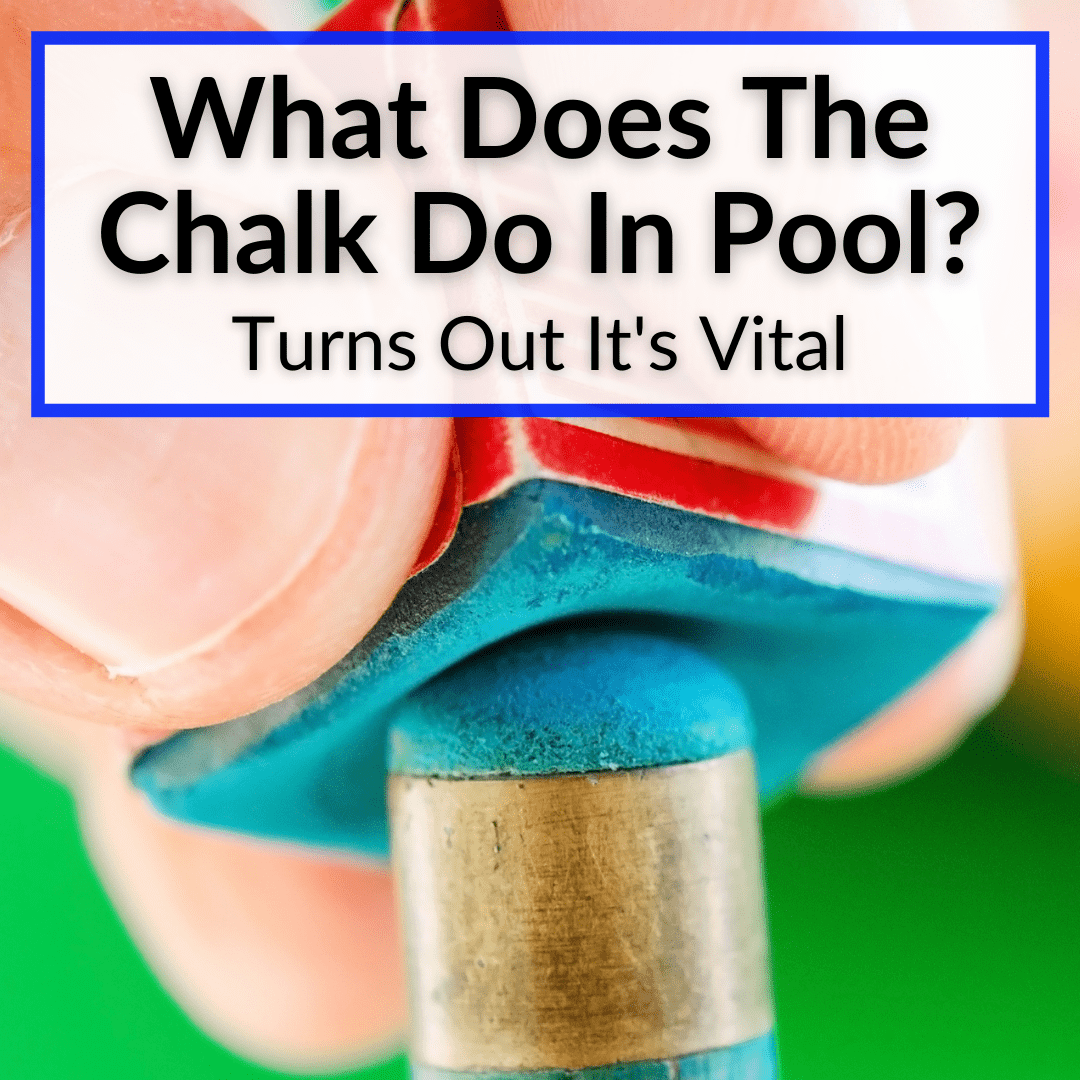 We’ve all seen pool players rub a cube of chalk on their pool cue tip.
We’ve all seen pool players rub a cube of chalk on their pool cue tip.
Chances are you’ve done the same yourself.
But do you know why you rub chalk on your pool stick? Does it actually do anything substantial to help your game?
Have you heard the expression “put some English on it?”
It refers to putting spin on the ball. The expression came from British players introducing spin shots to American players.
They achieved those shots using pool chalk. And it has other benefits as well.
Keep reading to learn all the reasons we put chalk on the tips of our pool cues. We’ll also cover how to chalk your tip properly and how often you should be doing it.
Table of Contents
What Does The Chalk Do In Pool?
British pool players were the first to discover the usefulness of pool chalk during the industrial revolution.
They were able to achieve more powerful shots and spin shots using chalk. Eventually introduced the use of chalk to American players.
As mentioned, that is where the phrase “put some English on it” comes from. If you’re not familiar with it, it refers to putting spin on shots, which is made more possible thanks to chalk.
It works because of friction. The added chalk on the pool cue tip increases the friction between the tip and the cue ball’s polished surface when the cue makes contact with the ball.
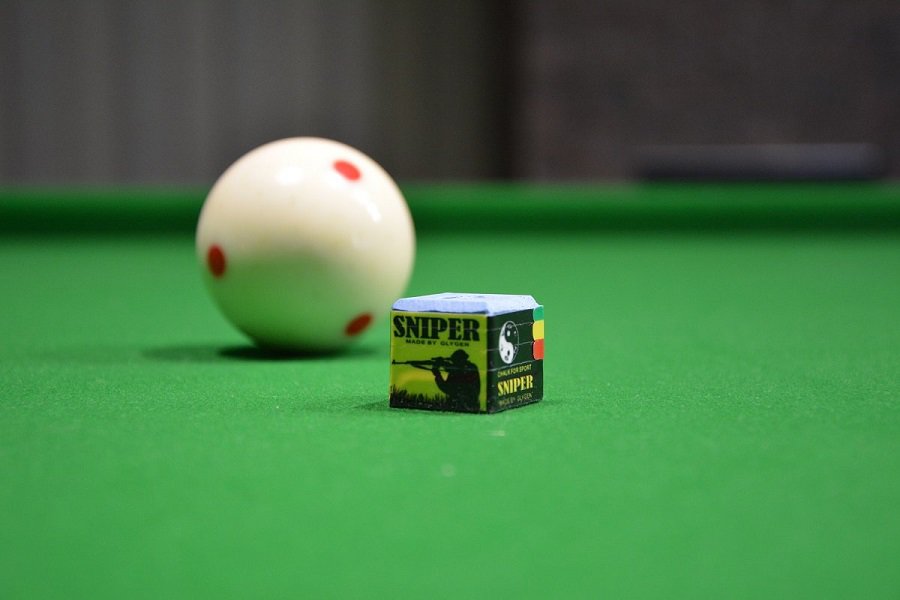
Whether you have a graphite pool cue or a wood one, the pool cue tip is usually made of leather or rubber. It has a firm surface. When hitting the smooth, round surface of the billiard ball, the tip may slip.
You need some friction to ensure this doesn’t happen, so that you can achieve an accurate shot when hitting the cue ball.
Many of the embarrassing breaks you’ve seen happened because there was inadequate chalk on the tip of the pool stick.
Using the appropriate amount of pool chalk has many benefits for players, all related to improved friction. Here are the most important benefits of using pool cue chalk.
- It makes the draw shots easier, because you can more accurately aim at the lower part of the cue ball.
- Follow shots are also easier; hitting the upper part of the cue ball is hard and often results in slips, but a good amount of chalk increases your chance of achieving a good shot.
- It makes it easier to add English to your shot.
- Pool chalk is necessary for powerful shots; strong break shots are almost impossible without chalk.
- It minimizes miscues.
- It improves tip and ferrule health.
Pool players often add pool chalk before every shot. In addition to adding friction, it also gives them some extra time to concentrate and focus on the shot.
Rubbing pool chalk on the tip of the stick may seem easy, but a lot of amateurs players actually do it wrong. This can damage the tip over the long run.
Plus, excess chalk on the balls can damage the table, which is why it is also important to keep your pool balls clean.
Let’s continue with some information and tips on correctly adding chalk to your pool cue.
How Often Should You Add Chalk To Your Cue?
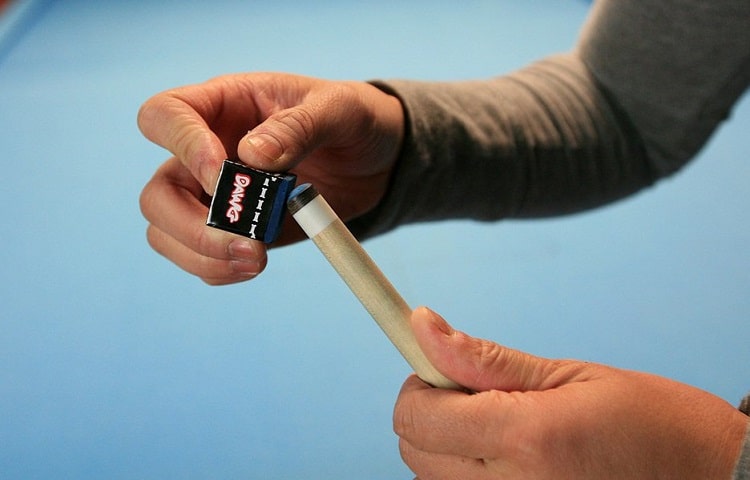
The answer depends on you. Some pool players chalk the pool cue before every shot. Others play several shots in a row without needing to add more chalk.
Professional shots often need extra spin. Spinning the ball without the proper amount of chalk is difficult, sometimes even impossible.
How many times you need to add chalk during a pool game also depends on the chalk material. Some chalks stick to the pool cue tip better and longer than others, so you may not need to chalk the tip before every shot.
The best way to know is to simply take a look at your pool cue tip before every shot. It should have an adequate amount of chalk, to give to the best shot accuracy. If it doesn’t, add more.
Can You Chalk Too Much?
Yes, you can. And using more chalk than needed on the pool cue has some disadvantages. The biggest is that the extra chalk ends up sticking to the balls and getting on the table.
I’m sure you’ve seen chalk marks on pool tables. That happens because players used too much chalk on their cues.
It results in the table needing to be cleaned more often, which takes time and increases costs for maintenance. If you don’t clean it off, it will end up damaging the felt.
That’s why you should always check the pool cue tip before each shot. Gently tap the pool cue to remove any loose chalk.
But don’t smack your pool stick on the table (or on anything else, for that matter) to remove the extra chalk. Seriously, I’ve seen people do this all the time….
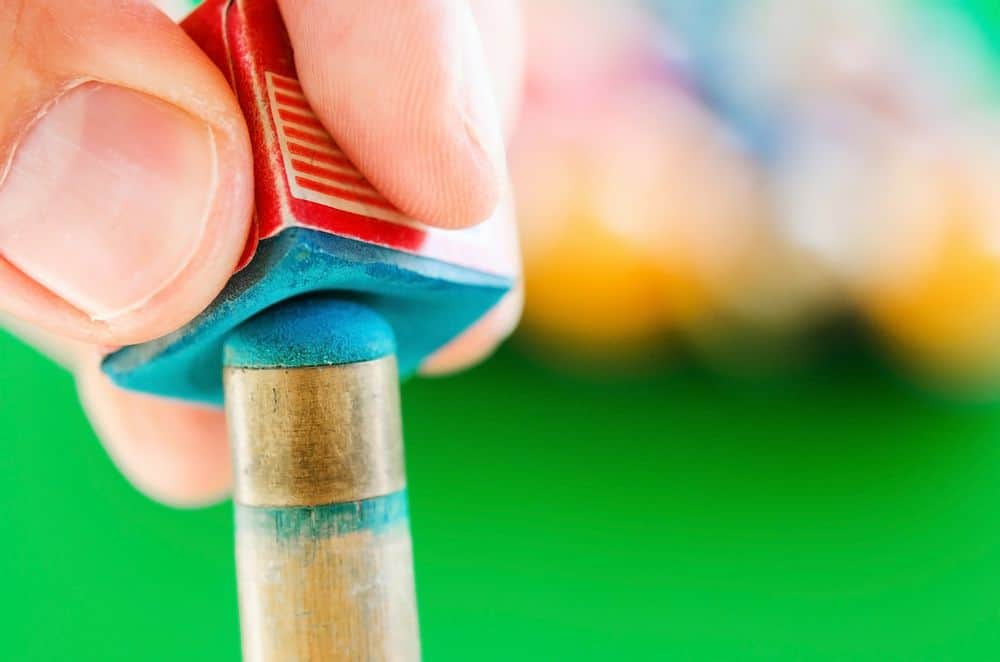
And don’t try to blow the loose chalk off. This actually has a negative effects on your shot accuracy. The moisture in your breath makes the chalk cakey and it does not add the needed friction as a result.
How To Chalk Your Pool Stick Properly
You know the chalk is necessary for each shot. But how best to chalk your pool cue? Consider the following tips when adding pool chalk:
- Tilt the pool cue at a low angle. Don’t hold the cue straight while adding the chalk. This will help you cover most parts of the cue tip with chalk.
- Add the chalk with a brushing motion. Turn the pool stick slowly to brush every part of the tip.
- Try using the whole area of the chalk cube. If you just use the center area, it will create a hole in the center. After a while, the chalk cube will cover the ferrule, which can damage the pool cue.
- Chalk the pool cue tip while standing away from the table or hold the pool stick with the tip away from table. Adding the chalk over the table causes extra chalk to fall onto the table, which can damage the felt.
- If you put the chalk cube on the table, face the colored area up. This will keep the table clean and your clothing and hands won’t get dirty, either.
- Apply the pool chalk like lipstick. Brush it wholly but gently and all over the tip.
Can You Play Pool Without Chalk?
Making a great break shot in pool requires chalk. You need that friction on your pool cue tip for strong shots.
Some players will take regular shots without adding pool chalk. But for spin and break shots, chalking is necessary.
If you want to avoid miscues in your game, consider chalking the tip before every shot. Even if you use a quality cue tip like the pros, it will be wasted without chalk.
What Is The Best Pool Chalk?
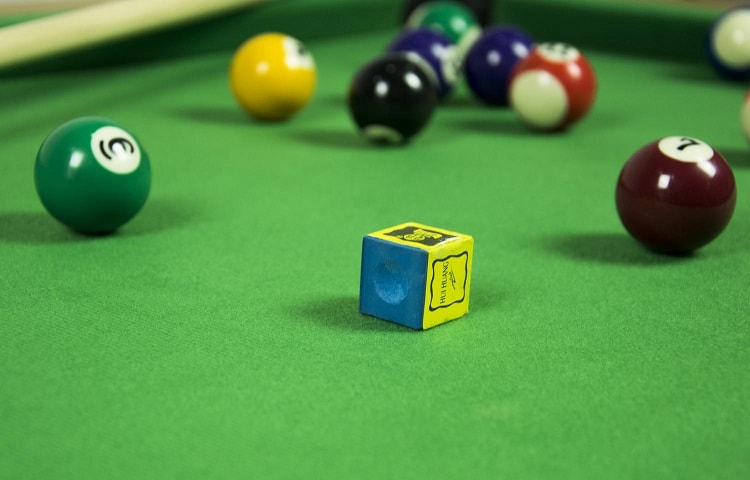
Pool chalks come in different sizes and colors. There are famous brands like Blue Diamond, Predator, Kamui, and Master that make high-quality chalks.
The material used in pool chalks is often the same. Manufacturers mass produce them using:
- Abrasive aluminum oxide
- Silicon
- Blue or green dye
Pool chalk cubes are usually made in 1-inch sizes. The size of pool chalk is not really important, but if you want to have a standard chalk like the champions use, stick to the 1-inch standard.
Blue and green are the most commonly used colors in pool chalks. But you can buy a chalk cube in various colors.
The usual recommendation is to buy pool chalk of the same color as your table felt. Chalk marks on the table are inevitable when playing with chalk. If you use the same color, you won’t see the chalk marks as much.
How To Clean Pool Chalk From Your Clothes
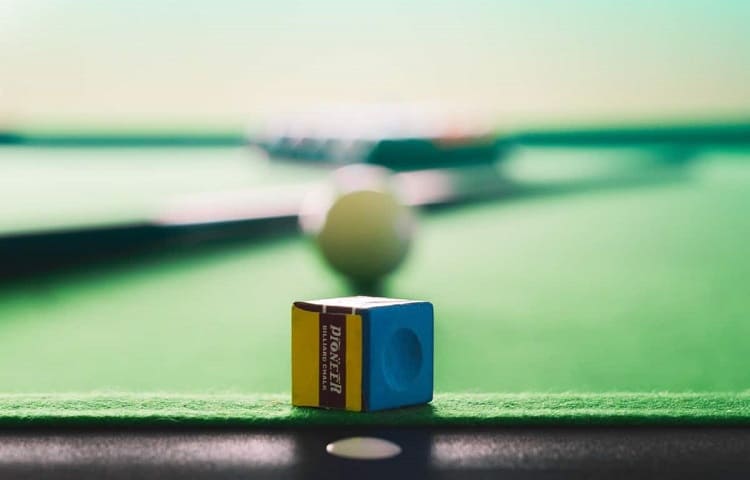
Pool chalk will often end up on your clothes, even if you’re very careful when chalking or when placing the cube on the table.
Luckily, it is not difficult to clean chalk stains from your clothes. How best to go about cleaning off the chalk depends on a few factors:
- The material of the chalk
- The material of your clothes
- How long the stain has been on your clothes
Generally, it is a good idea to use a laundry stain remover on the chalk stain before dry cleaning your clothes.
Always get help from dry cleaners to remove a stubborn chalk stain. Remember to point out the stain’s location so that the dry cleaner knows to put extra effort into it.
What Pool Chalk Does: Conclusion
Rubbing pool chalk on the pool cue tip is necessary for powerful and spin shots. It adds extra friction between the tip and the ball. Without the chalk, your regular shots have a greater chance of misfiring, too.
Most pool players chalk their pool cue tip before every shot. In addition to adding friction, it also gives them extra time to focus on the shot.
The best way to chalk the pool cue tip is to do it like a lady putting on lipstick. You need to do it gently and the chalk should cover the whole tip area.
Be careful to not only use the center of the chalk. It creates a hole in the cube, making it useless for continued use.
If you want to win games, you need to be using pool chalk. Without it, you just won’t be able to get the same power and accuracy on your shots. That is why using chalk is also included among our 19 pool playing tips.
Leave a Reply